
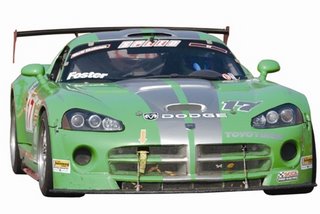
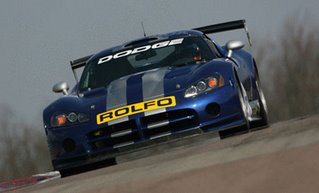
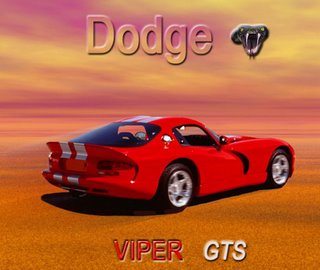
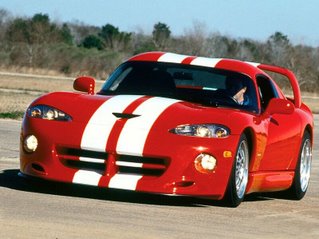

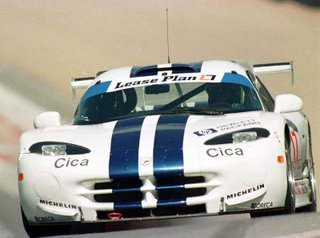
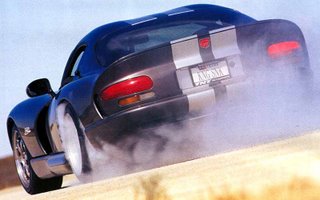
The Dodge Viper is a two-seat sports car, the most powerful production car made by Dodge. Viper production began at New Mack Assembly in 1992 and moved to its current home at Connor Avenue Assembly in October 1995.The Viper was conceived as a modern take on the classic American muscle car. While there are some who insist that the iconic AC Cobra was a source of inspiration, the final version of the Viper was far too large and heavy to seriously claim any direct lineage with the compact and lightweight vehicle. Most saw claims to kinship with the Cobra as a marketing exercise, although Carroll Shelby was involved in the initial design of the Viper.
The Viper was initially conceived in late 1987 at Chrysler's Advanced Design Studios. The following February, Chrysler president Bob Lutz suggested to Tom Gale at Chrysler Design that the company should consider producing a modern Cobra, and a clay model was presented to Lutz a few months later. The car appeared as a concept at the North American International Auto Show in 1989, and public reaction was so enthusiastic, that chief engineer Roy Sjeoberg was directed to develop it as a production car.
Sjoberg selected 85 engineers to be "Team Viper", with development beginning in March 1989. The team asked then-Chrysler subsidiary Lamborghini to cast some prototype aluminum blocks based on their V10 truck engine for sports car use in May. The production body was completed in the fall, with a chassis prototype running in December. Though a V8 was first used in the test mule, the V10 which the production car was meant to use was ready in February 1990.
Official approval from Chrysler chairman, Lee Iacocca, came in May 1990. One year later, Carroll Shelby piloted a preproduction car as the Indianapolis 500 pace car. In November 1991, the car was released to reviewers with first shipments beginning in January 1992.
The first prototype was tested in December 1989. It first debuted in 1991 with three pre-production models as the pace car for the Indianapolis 500 when Dodge was forced to substitute it in place of the Stealth, and went on sale in January 1992 as the soft roofed RT/10 Roadster.
The centerpiece of the car was its engine. Originally designed as a truck engine and based on the Chrysler LA engine, , then a division of the Chrysler Corporation, revamped Dodge's cast-iron block V10 for the Viper by recasting the block and head in aluminum alloy, and giving the engine a significant power boost. Some within Lamborghini felt the pushrod two-valve design, while adequate for the truck application for which the engine was originally created, was unsuitable for a performance car and suggested a more comprehensive redesign which would have included four valves per cylinder. However, Chrysler was uncertain about the Viper's production costs and sales potential and so declined to provide the budget for the modification.
The engine produced 400 hp (298 kW) at 4600 rpm and 450 ft·lbf (610 N·m) of torque at 3600 rpm, and thanks to the long-gearing allowed by the torquey engine, provided surprising fuel economy at a claimed 21 mpg US (11.2 L/100 km) if driven sedately. The body was a tubular steel frame with resin transfer molding (RTM) fiberglass panels. Typical of American performance car design, it had a front-mounted engine driving the rear wheels; it was also heavy with a curb weight of 3,280 lb (1,488 kg) and lacked many modern driver aids such as traction control or anti-lock brakes. Car and Driver magazine referred to this generation as "the world's biggest Fat Boy Harley", and likened driving it to "playing ping pong with a Louisville Slugger baseball bat." Despite this, in straight line performance, it completed a quarter mile in 12.9 seconds and had a maximum speed of 164 mph (264 km/h).
Suspension on the first-gen Viper was equally frugal, with many front-end pieces coming directly from the Dakota pickup truck.
Second generation models increased engine power, improved suspension, and reduced braking distances; the 1996 to 2002 Viper GTS had a 450 bhp (336 kW) engine, which could complete the quarter mile 0.7 seconds faster and increased top speed by 35 km/h (22 mph) or so. A number of third party firms have modified the car to boost performance.
A coupe model, called the GTS, was also introduced in 1996. An interesting feature of the coupe was the "double bubble" roof contours; two small humps to accommodate drivers wearing helmets. Indeed, the Viper's performance has made the vehicle popular for both amateur and professional racers. Vipers can be seen participating often in drag racing, road racing and drifting. The GTS, like its predecessor, was chosen as the pace car for the 1996 Indianapolis 500.
Dodge contracted French racing team Oreca to build a racing version of the Viper known as the GTS-R in the FIA GT Championship's GT2 category, where they won the series in 1997, 1998, 1999, 2001 and 2002 (the last two with Larbre Competition). The car also won its class in the Le Mans 24 Hours from 1998 to 2000 and took overall win at the 24 hours of Daytona. Dodge would celebrate by releasing a special edition model with the winning car's livery.
In the first six years of production almost 10,000 Vipers were sold. The second generation Vipers were exported to Europe, where they were sold as Chryslers.
The 1999 model was the last Viper that had forged pistons. Subsequent years had lighter-weight, hypereutectic pistons similar to other sports cars, as well as improved exhaust systems. Also in 1999, the American Club Racing (ACR) model was introduced. This model featured suspension and engine enhancements focused on maximizing performance in road racing and autocross environments. Horsepower was bumped to 460 bhp in these models. Continuing chassis refinements, ABS braking was introduced in 2001. In 2002, the end of second generation production was celebrated with the release of 360 commemorative "Final Edition" models. These models were painted red with white stripes, paying tribute to the famous race-winning Oreca cars.
The Dodge Viper underwent a major redesign in 2003, courtesy of DaimlerChrysler's Street and Racing Technology (SRT) group. The new Viper SRT-10 was heavily restyled with sharp, angled bodywork. The engine was enlarged to 8.3 L which, with other upgrades, combined to increased output to 504 hp (375 kW) and 525 ft·lbf (711 N·m) of torque. The initial model was a convertible.
The new Viper SRT-10 Coupe (no longer called the GTS) was introduced in 2005 at the Detroit Auto Show as a 2006 model. It shares many of its body panels with the convertible but takes its side and rear styling cues from the Competition Coupe (see below). The new coupe looks much like the previous Viper GTS and retains the "double-bubble" roof shape of the original, along with the original GTS's taillights, for an added homage to the original Viper coupe. In addition to these style upgrades, the Viper receives 510 hp (380 kW) and 525 ft·lbf (711 N·m) of torque.
The third generation Viper has been sold in Europe since 2004, the first model to be sold as a Dodge, as part of Chrysler's new sales strategy for the European market. It's however sold as the "Dodge SRT-10", as the Viper name is a registered trademark in the UK.
The Viper was initially conceived in late 1987 at Chrysler's Advanced Design Studios. The following February, Chrysler president Bob Lutz suggested to Tom Gale at Chrysler Design that the company should consider producing a modern Cobra, and a clay model was presented to Lutz a few months later. The car appeared as a concept at the North American International Auto Show in 1989, and public reaction was so enthusiastic, that chief engineer Roy Sjeoberg was directed to develop it as a production car.
Sjoberg selected 85 engineers to be "Team Viper", with development beginning in March 1989. The team asked then-Chrysler subsidiary Lamborghini to cast some prototype aluminum blocks based on their V10 truck engine for sports car use in May. The production body was completed in the fall, with a chassis prototype running in December. Though a V8 was first used in the test mule, the V10 which the production car was meant to use was ready in February 1990.
Official approval from Chrysler chairman, Lee Iacocca, came in May 1990. One year later, Carroll Shelby piloted a preproduction car as the Indianapolis 500 pace car. In November 1991, the car was released to reviewers with first shipments beginning in January 1992.
The first prototype was tested in December 1989. It first debuted in 1991 with three pre-production models as the pace car for the Indianapolis 500 when Dodge was forced to substitute it in place of the Stealth, and went on sale in January 1992 as the soft roofed RT/10 Roadster.
The centerpiece of the car was its engine. Originally designed as a truck engine and based on the Chrysler LA engine, , then a division of the Chrysler Corporation, revamped Dodge's cast-iron block V10 for the Viper by recasting the block and head in aluminum alloy, and giving the engine a significant power boost. Some within Lamborghini felt the pushrod two-valve design, while adequate for the truck application for which the engine was originally created, was unsuitable for a performance car and suggested a more comprehensive redesign which would have included four valves per cylinder. However, Chrysler was uncertain about the Viper's production costs and sales potential and so declined to provide the budget for the modification.
The engine produced 400 hp (298 kW) at 4600 rpm and 450 ft·lbf (610 N·m) of torque at 3600 rpm, and thanks to the long-gearing allowed by the torquey engine, provided surprising fuel economy at a claimed 21 mpg US (11.2 L/100 km) if driven sedately. The body was a tubular steel frame with resin transfer molding (RTM) fiberglass panels. Typical of American performance car design, it had a front-mounted engine driving the rear wheels; it was also heavy with a curb weight of 3,280 lb (1,488 kg) and lacked many modern driver aids such as traction control or anti-lock brakes. Car and Driver magazine referred to this generation as "the world's biggest Fat Boy Harley", and likened driving it to "playing ping pong with a Louisville Slugger baseball bat." Despite this, in straight line performance, it completed a quarter mile in 12.9 seconds and had a maximum speed of 164 mph (264 km/h).
Suspension on the first-gen Viper was equally frugal, with many front-end pieces coming directly from the Dakota pickup truck.
Second generation models increased engine power, improved suspension, and reduced braking distances; the 1996 to 2002 Viper GTS had a 450 bhp (336 kW) engine, which could complete the quarter mile 0.7 seconds faster and increased top speed by 35 km/h (22 mph) or so. A number of third party firms have modified the car to boost performance.
A coupe model, called the GTS, was also introduced in 1996. An interesting feature of the coupe was the "double bubble" roof contours; two small humps to accommodate drivers wearing helmets. Indeed, the Viper's performance has made the vehicle popular for both amateur and professional racers. Vipers can be seen participating often in drag racing, road racing and drifting. The GTS, like its predecessor, was chosen as the pace car for the 1996 Indianapolis 500.
Dodge contracted French racing team Oreca to build a racing version of the Viper known as the GTS-R in the FIA GT Championship's GT2 category, where they won the series in 1997, 1998, 1999, 2001 and 2002 (the last two with Larbre Competition). The car also won its class in the Le Mans 24 Hours from 1998 to 2000 and took overall win at the 24 hours of Daytona. Dodge would celebrate by releasing a special edition model with the winning car's livery.
In the first six years of production almost 10,000 Vipers were sold. The second generation Vipers were exported to Europe, where they were sold as Chryslers.
The 1999 model was the last Viper that had forged pistons. Subsequent years had lighter-weight, hypereutectic pistons similar to other sports cars, as well as improved exhaust systems. Also in 1999, the American Club Racing (ACR) model was introduced. This model featured suspension and engine enhancements focused on maximizing performance in road racing and autocross environments. Horsepower was bumped to 460 bhp in these models. Continuing chassis refinements, ABS braking was introduced in 2001. In 2002, the end of second generation production was celebrated with the release of 360 commemorative "Final Edition" models. These models were painted red with white stripes, paying tribute to the famous race-winning Oreca cars.
The Dodge Viper underwent a major redesign in 2003, courtesy of DaimlerChrysler's Street and Racing Technology (SRT) group. The new Viper SRT-10 was heavily restyled with sharp, angled bodywork. The engine was enlarged to 8.3 L which, with other upgrades, combined to increased output to 504 hp (375 kW) and 525 ft·lbf (711 N·m) of torque. The initial model was a convertible.
The new Viper SRT-10 Coupe (no longer called the GTS) was introduced in 2005 at the Detroit Auto Show as a 2006 model. It shares many of its body panels with the convertible but takes its side and rear styling cues from the Competition Coupe (see below). The new coupe looks much like the previous Viper GTS and retains the "double-bubble" roof shape of the original, along with the original GTS's taillights, for an added homage to the original Viper coupe. In addition to these style upgrades, the Viper receives 510 hp (380 kW) and 525 ft·lbf (711 N·m) of torque.
The third generation Viper has been sold in Europe since 2004, the first model to be sold as a Dodge, as part of Chrysler's new sales strategy for the European market. It's however sold as the "Dodge SRT-10", as the Viper name is a registered trademark in the UK.





No comments:
Post a Comment